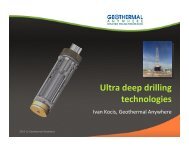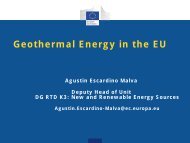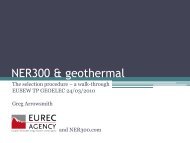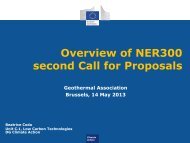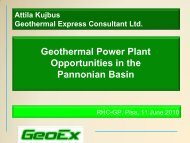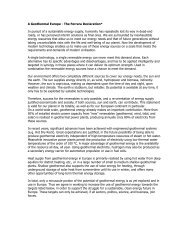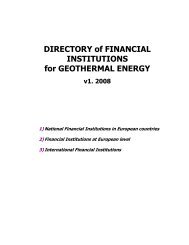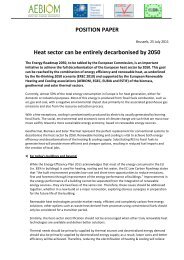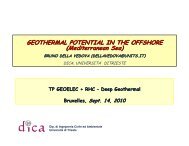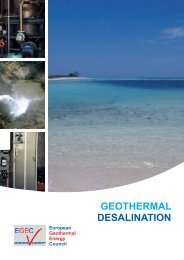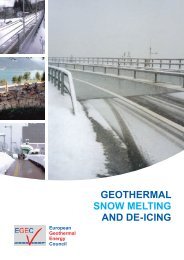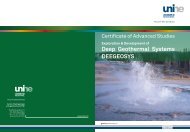Strategic Research and Innovation Agenda for Renewable ... - EGEC
Strategic Research and Innovation Agenda for Renewable ... - EGEC
Strategic Research and Innovation Agenda for Renewable ... - EGEC
Create successful ePaper yourself
Turn your PDF publications into a flip-book with our unique Google optimized e-Paper software.
<strong>Renewable</strong>Heating & CoolingEuropean Technology Plat<strong>for</strong>mCCT.10ObjectiveState-of-the-artTargetsType of activityIntegration, automation <strong>and</strong> control of large scale hybrid systems<strong>for</strong> non-residential buildingsEf<strong>for</strong>ts should be put into developing large (>100kW) hybrid systems with the followingcharacteristics:• Improved efficiency through:• well-designed systems (good hydraulic layout, exergetic optimization,…);• control systems that optimise the energy consumption <strong>and</strong> take advantage of theavailability of renewable energy (optimise solar gain, increase sCOP, increase meansystem efficiency,…);• embedded equipment <strong>for</strong> energy monitoring to have a clear picture of the energyproduction, cost of primary energy consumed <strong>and</strong> amounts of GHG emitted;• more rapid failure detection, signalled, <strong>for</strong> example, by excessive primary energyconsumption <strong>and</strong> notification of the user <strong>and</strong> or service company• Weather <strong>for</strong>ecast, based on local observation <strong>and</strong>/or services available by internet.• Heating/Cooling <strong>and</strong> DHW load <strong>for</strong>ecast, based on the learning of system operation<strong>and</strong> occupants’ behaviour.• New processing algorithms to supervise the complete system (adaptive control,learning process, etc.) while maintaining a high degree of com<strong>for</strong>t <strong>and</strong> a low consumptionof auxiliary electricity• Load shift potential to be used only with storages (buffer storages, building envelopeused as thermal storage)• Smart grid integration• Development of new business models <strong>and</strong> load shift tariffsA few demo projects exist; system efficiencies are rather low compared to single technologiesdue to poor per<strong>for</strong>mance of control, failure detection, etc.Payback time of 5 to 7 years of the additional investment cost <strong>for</strong> the hybrid system comparedto a st<strong>and</strong>alone solution due to the optimum use of RES <strong>and</strong> the use of flexible energy tariffs.50% Development / 50% Demonstration4.5.2 <strong>Research</strong> <strong>and</strong> innovation priorities <strong>for</strong> Heat Pump technology<strong>and</strong> Hybrid Systems with impact in the Medium <strong>and</strong> Long TermCCT.11ObjectiveState-of-the-artSorption cooling systems driven by hot water at moderate temperatureThe development of new or improved sorption systems <strong>for</strong> production of chilled water<strong>for</strong> cooling of buildings driven by low temperature heat sources, as <strong>for</strong> instance solar.The expected outcome also includes the development of optimised solutions <strong>for</strong> the heatrejection, fully reliable <strong>and</strong> automatised operation, <strong>and</strong> easy integration with other systems.Sorption technology has significantly improved in the past years. However an increase inthe efficiency of the whole system, including heat rejection <strong>and</strong> auxiliaries, <strong>and</strong> an increasein reliability need to be carried out to improve its application potential in the mentioned sector.Targets • Capacity around 100 kW <strong>and</strong> temperature of the hot source ranging from 60 to 90 ºCthe system should achieve at least a sCOP value of 0.7.• Payback period of the investment must be less than 8 years, also in comparison withan electrical chiller.Type of activity20% <strong>Research</strong> / 50% Development / 30% Demonstration<strong>Research</strong> <strong>and</strong> <strong>Innovation</strong> Priorities Predominant type of activity ImpactCCT.9CCT.10CCT.11High capacity heat pump <strong>for</strong> simultaneous productionof cold <strong>and</strong> hot water <strong>for</strong> heating/cooling the buildingIntegration, automation <strong>and</strong> control of large scalehybrid systems <strong>for</strong> non-residential buildingsSorption cooling systems driven by hot waterat moderate temperatureDevelopment By 2020Development / Demonstration By 2020Development By 2030Table 10: research <strong>and</strong> innovation priorities <strong>for</strong> cross-cutting technology applicationsto non-residential buildings49



